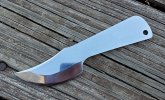Tyson A Wright
Gold Member
- Joined
- Jun 9, 2020
- Messages
- 1,903
Why not bamboo, then? You said nobody uses it, but I've seen bamboo-handled knives.
The BladeForums.com 2024 Traditional Knife is ready to order! See this thread for details:
https://www.bladeforums.com/threads/bladeforums-2024-traditional-knife.2003187/
Price is $300 $250 ea (shipped within CONUS). If you live outside the US, I will contact you after your order for extra shipping charges.
Order here: https://www.bladeforums.com/help/2024-traditional/ - Order as many as you like, we have plenty.
Not sure, but the bamboo handles I have seen on western knives have used the resin impregnated bamboo material, similar to what is used for flooring, so much denser than the raw material. what I have seen of bamboo is that it is very splintery.Why not bamboo, then? You said nobody uses it, but I've seen bamboo-handled knives.

Thanks for the informative reply, Chris. Is it possible there are two different composite materials both named G-10?There is no such thing as "Phenolic G10". G10 is a code that is specifically a glass/epoxy material. There are glass/phenolic laminates, but they have other designations.
Why not bamboo, then? You said nobody uses it, but I've seen bamboo-handled knives.
Alro is using the term "Phenolic" like it is a generic catch all for fabric/resin composites. That is marketing rather than material specification. Their own data sheets, with the word Phenolic at the top, show the materials they are listing do not contain phenolic resin. G-9 glass/melamine, G-10 glass/epoxy, G-11 Glass/Epoxy and G-7 glass/silicone. Alro is an industrial supply company, so laminate materials is a very small part of the diverse range of products they sell on. I.... Chris. Is it possible there are two different composite materials both named G-10?
Amazon.com: Phenolic G-10 Glass Grade Sheet, Tan, 0.031" Thick, 24" Width, 24" Length : Industrial & Scientific
Amazon.com: Phenolic G-10 Glass Grade Sheet, Tan, 0.031" Thick, 24" Width, 24" Length : Industrial & Scientificwww.amazon.com
...
C CallumRD1Here's another case study for people. I machined these blanks out of 0.118" AEB-L so they're all identical, ground the same, use the same 3/16" 304 stainless pins, and have the same handle thickness. The one with non-stabilized walnut scales has a fully skeletonized tang like the unfinished one at the bottom. The one with stabilized curly mango scales is also fully skeletonized. The one with non-stabilized oak scales is not skeletonized but has a full tang. The weights are below. Without changing the blade or scale materials, more weight could be shed by switching to less dense and/or smaller diameter pins or by tapering the tang. I'd like to experiment with how tapering the tang moves the balance point forward. The walnut one feels perfect in my hand, but I'd like to retain that balance while using a heavier scale material. I may also try titanium pins. Based on some back of hand math, that alone would save ~3.5 g in the handle.
Unstabilized walnut with skeletonized tang: 82.2 g (2.90 oz)
Stabilized curly mango with skeletonized tang: 96.0 g (3.39 oz)
Unstabilized oak with non-skeletonized tang: 111.1 g (3.92 oz)
Bamboo from food table ........................I like it .I can measure new table if that matter ?Not sure, but the bamboo handles I have seen on western knives have used the resin impregnated bamboo material, similar to what is used for flooring, so much denser than the raw material. what I have seen of bamboo is that it is very splintery.

Bolstermanic If you look at the chart you posted of handle materials and go all the way from delrin to European walnut you're only talking a difference of 1/2 ounce per cubic inch. That translates to a 1.5 ounce difference for knife handles between both extremes.

Sweet ^ looking blade, that! Looks both lightweight and sturdy. Yes, there's a good case to be made for going completely skeletonized, especially if you've something like a bandana or cordage you can double-duty for cushion. Currently this is my backpacking knife; it's down to 2.4 oz, naked. Heavily chamfered all over. UL backpacking is an expensive disease. I hope you don't catch it...whatever you do, don't visit backpackinglight.comWhy not skip handles completely then? Round off the edges off you tang a bit for comfort and you're good to go.

I don't think an ultralight backpacker would ever use 550 cord, it's just way too heavy compared to Spectra/Dyneema or Vectran.Sounds like a good reason to go with a wrapped 550 cord handle, you can use it as a "ridge line" on your tent, then wrap it back on the handle when you pack up camp...
Regardless of what material is used the idea remains the same...I don't think an ultralight backpacker would ever use 550 cord, it's just way too heavy compared to Spectra/Dyneema or Vectran.
